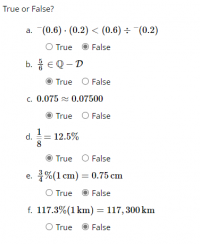Approximations
- Thread starter Zelda22
- Start date
Dr.Peterson
Elite Member
- Joined
- Nov 12, 2017
- Messages
- 16,809
It isn't even a matter of rounding; they are the very same number, because the zeros at the end have no effect.True or False?
0.075≈0.07500
I think is true, 0.075 rounded to the nearest hundred thousandths is 0.07500.
Am I missing anything here? Seems too simple. Thanks
Most likely this was among other questions that look similar but aren't nearly equal, while this one might lead to the opposite error.
Can you show us the context (e.g. a few questions near it)? What makes me curious is why they are asking about approximation rather than equality.
Thank you. Here is the original question.It isn't even a matter of rounding; they are the very same number, because the zeros at the end have no effect.
Most likely this was among other questions that look similar but aren't nearly equal, while this one might lead to the opposite error.
Can you show us the context (e.g. a few questions near it)? What makes me curious is why they are asking about approximation rather than equality.
Attachments
Dr.Peterson
Elite Member
- Joined
- Nov 12, 2017
- Messages
- 16,809
They're all either trivial or tricky, so I guess they belong together!Thank you. Here is the original question.
Are my answers correct?They're all either trivial or tricky, so I guess they belong together!
Dr.Peterson
Elite Member
- Joined
- Nov 12, 2017
- Messages
- 16,809
Yes, except I don't know what D means here:Are my answers correct?
For example, it isn't listed here.
Like Dr. Peterson, I’d like to know more about the context because, in certain contexts, the number of decimal points specifies information about the precision of estimates.
Absent some convention about precision, a≈b does not entail that a=b.
That is, I interpret
a≈b⟺0≤∣a−b∣<ϵ, whereϵ is a positive number that, under the circumstances, is not material.
Absent some convention about precision, a≈b does not entail that a=b.
That is, I interpret
a≈b⟺0≤∣a−b∣<ϵ, whereϵ is a positive number that, under the circumstances, is not material.
0.075 is in D3 and 0.07500 is in D5Like Dr. Peterson, I’d like to know more about the context because, in certain contexts, the number of decimal points specifies information about the precision of estimates.
Absent some convention about precision, a≈b does not entail that a=b.
That is, I interpret
a≈b⟺0≤∣a−b∣<ϵ, whereϵ is a positive number that, under the circumstances, is not material.
I understand there are some rational numbers that their approximation to D3 is 0.075 and D5 is not 0.07500.
But I'm not sure if that's what this question is asking.
For example,
r=0.075160
Approximation to D3=0.075
Approximation to D5=0.07516
Would be ok to say that 0.075 is approximately equal to 0.07500?
r ∈ Da decimal is any rational number that has a simple fractional name whose denominator is 1 or a power of 10. Such a fractional name is called a decimal name.
if and only if, r ∈ D0, or r ∈ D1, or r ∈ D2...etc
topsquark
Senior Member
- Joined
- Aug 27, 2012
- Messages
- 2,370
Okay, so does 5/6 belong to one of these D's?r ∈ D
if and only if, r ∈ D0, or r ∈ D1, or r ∈ D2...etc
-Dan
No. a/b if b is divisible by a prime number other than 2 or 5 is not en element of any DOkay, so does 5/6 belong to one of these D's?
-Dan
D0=Z
D1= Z/10
D2= Z/100
….
I think so.So 65∈/D So would it be in Q−D?
-Dan
D
Deleted member 4993
Guest
In "measurement" sciences those are not equal - because those numbers will have implied accuracy statement.The statement translates to "0.075 is almost equal to 0.07500."
As they are actually equal to each other, this statement is then false.
It is really important to know the reference (context) of this question.
In "measurement" sciences those are not equal - because those numbers will have implied accuracy statement.
It is really important to know the reference (context) of this question.
Yes, I deleted my post soon after I made it (as you can see) and gave you a thumbs-up.
x≈y it means "x" is the best approximation for "y" to the number of decimal places displayed in "x"It isn't even a matter of rounding; they are the very same number, because the zeros at the end have no effect.
Most likely this was among other questions that look similar but aren't nearly equal, while this one might lead to the opposite error.
Can you show us the context (e.g. a few questions near it)? What makes me curious is why they are asking about approximation rather than equality.
It would truly help us help you if you would give us the formal definition of D, particularly if there are different kinds of D.
This looks more and more as if we are talking about some exact definition for the approximation symbol.
D=D0 U D1 U D2 U D3…….It would truly help us help you if you would give us the formal definition of D, particularly if there are different kinds of D.
This looks more and more as if we are talking about some exact definition for the approximation symbol.
DO=Z
D1=Z/10
D2=Z/100
D3=Z/1000
…
a/b if b is divisible by a prime number other than 2 or 5 is not en element of any D
For example 1/3 is not in D,
( There is not an equivalent fraction with 1 or power of 10 as denominator )
And 1/8 is in D because 1/8 =125/1000 (D3)
These are my notes


